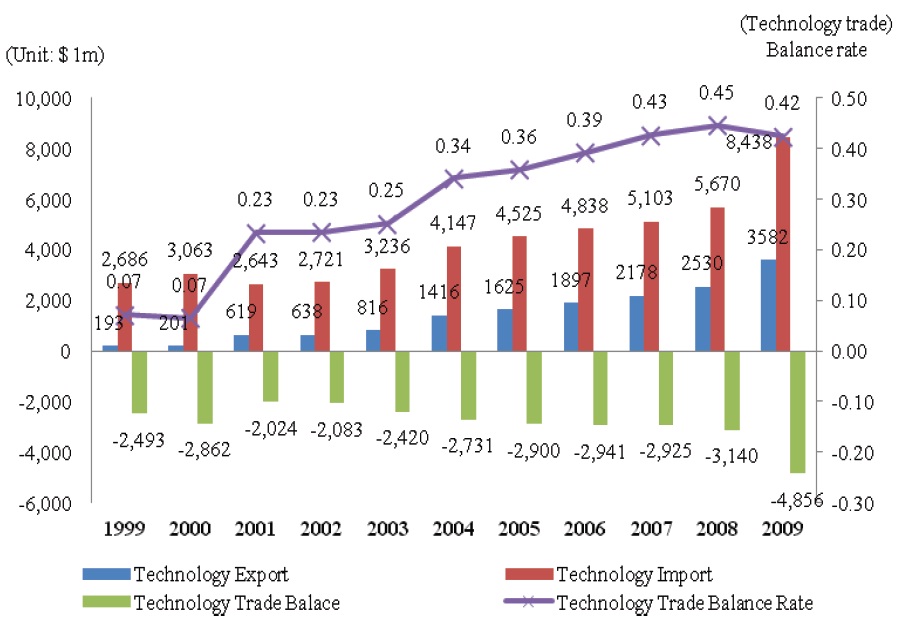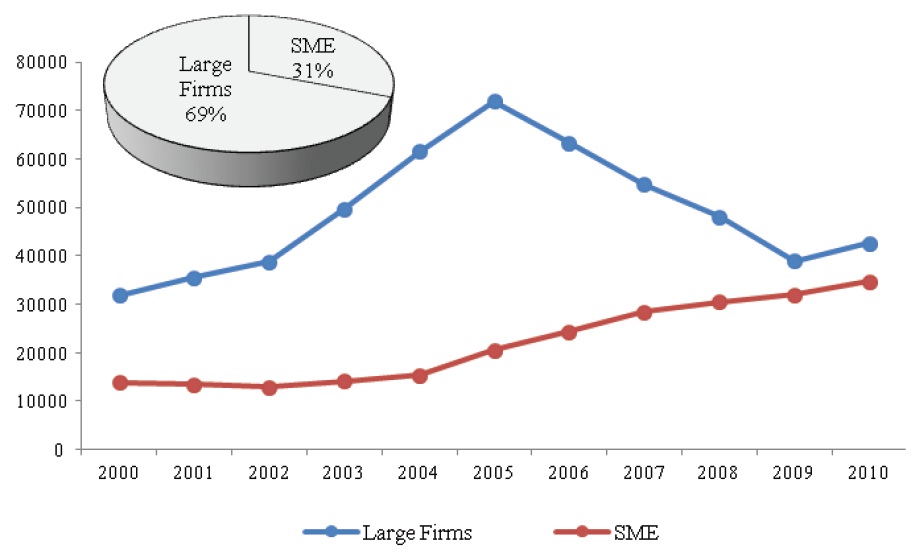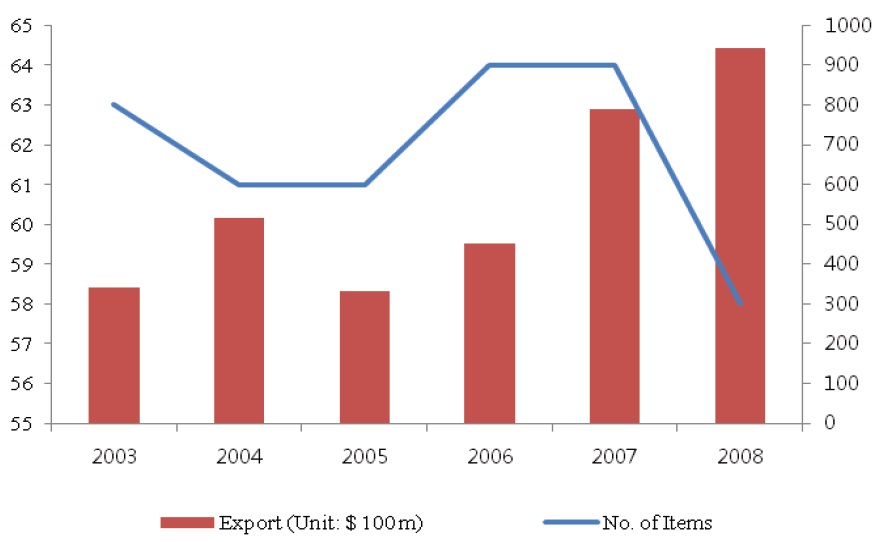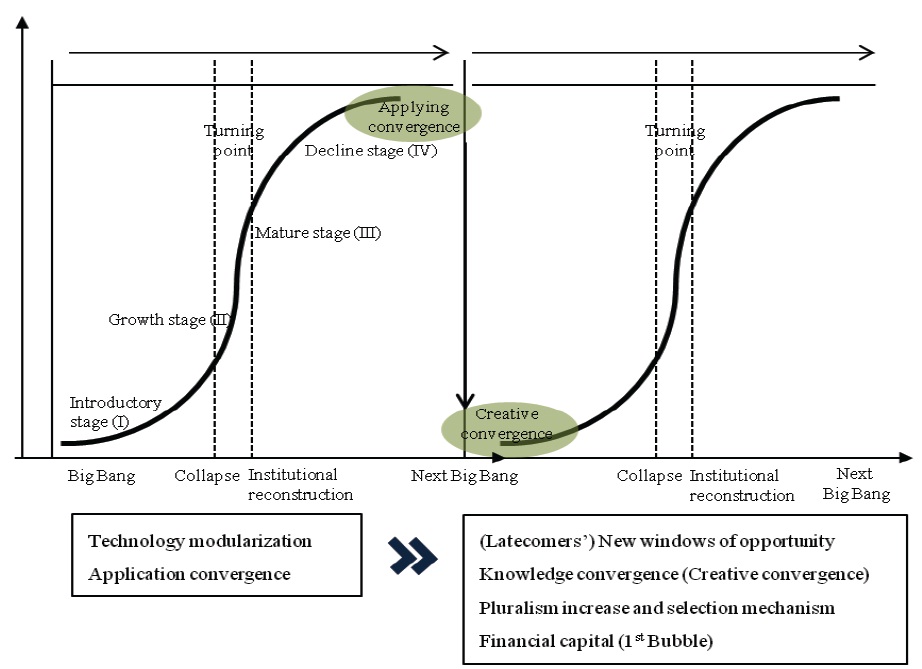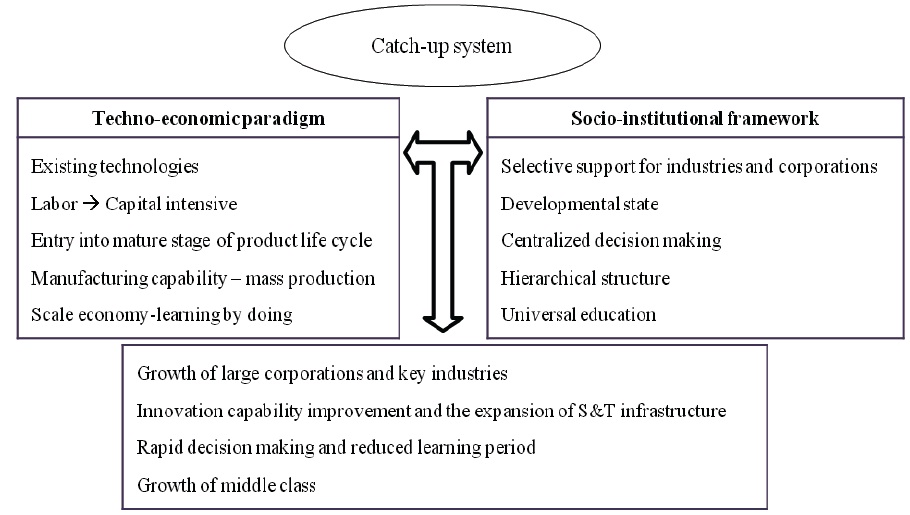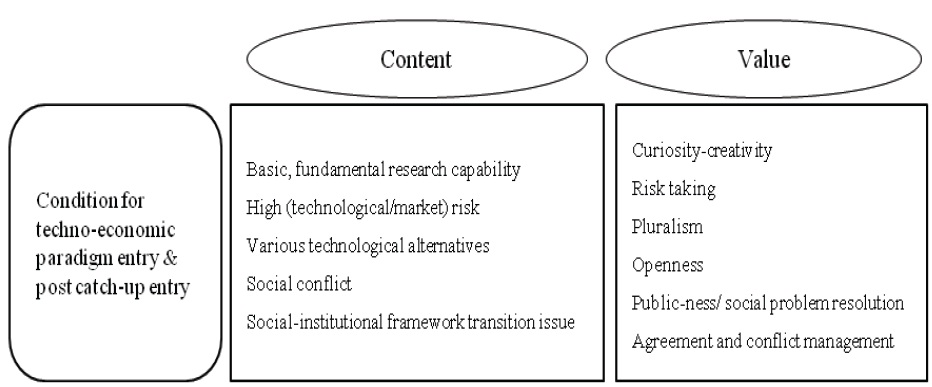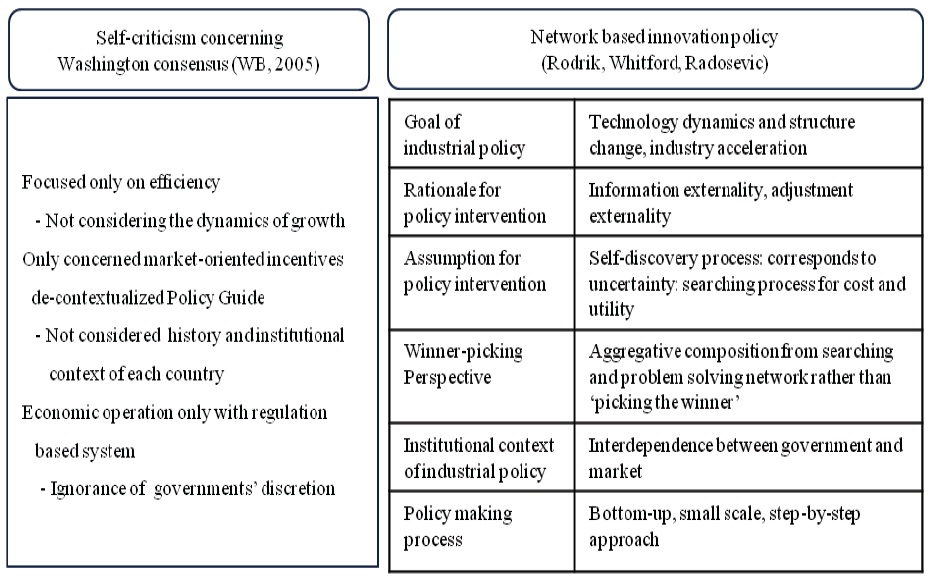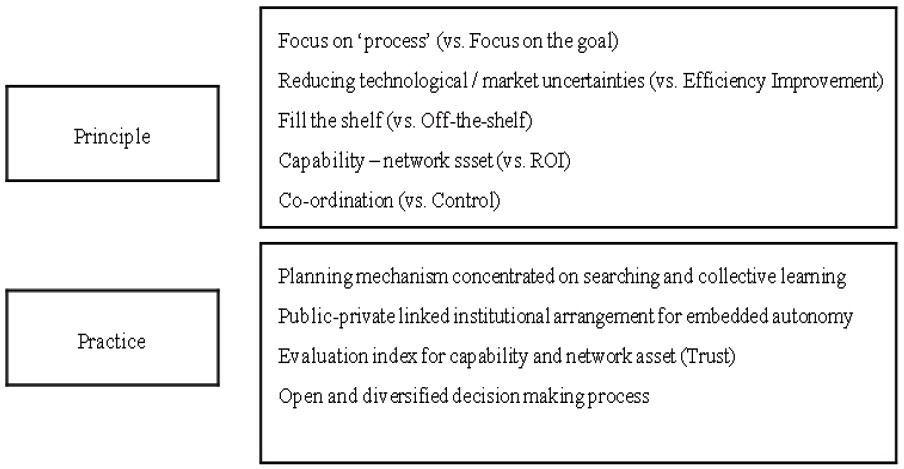



Korean R&D investment and performance in science and technology sector has grown rapidly. Aggressive investment in research and development resources has continued to grow, such that the proportion of R&D expenditure to GDP became 4.03% by 2011: the second largest in the world. However, the socio-economic effect derived from R&D investment, paradoxically, is decreasing. There are direct impacts from the technology trade deficit with lowered quality patents and indirect factors of weakened overall international competitiveness along with expansion of social polarization.
Some contend that the European paradox, the drop of performance per 457 R&D investment in the early 2000s, can reappear in Korea. This article attempts to understand this low performance paradox from a ‘system failure’ perspective. It will analyze the delay of performance creation, within the context of system transition delays in the process of breaking through the previous catch-up innovation system.
The catch-up innovation system was well suited to the industrialization process of the Korean economy, and contributed to rapid learning, technology acquisition, productivity improvement, and industry acceleration. However, as this catch-up innovation system was exposed to a new competition environment, in which second-tier catch-up countries reduced the gap with Korea and advanced Korean firms entered into the frontier product market, it is experiencing system delay in terms of organization and policy change. As Korea moves beyond its catch-up period, it requires more R&D activities for original basic technology, and a change in the innovation environment that retains technological and industrial innovation diversity. Moreover, the desire for change in the innovation system is increasing in such areas as knowledge production, diffusion in convergence technology, and technology diffusion to SMEs.
Therefore, innovation policy needs to be reorganized from a dynamic perspective to analyze the problems in the transition period and enable the system to overcome organizational and institutional delays. During the period of system stability, effectiveness of resource distribution and consistency of policies were the key issues of innovation policy. However, during the system transition period, reestablishment of new system values and principles, contents for institutional arrangements, principles for the relationship among innovation actors, and transition methods should be emphasized as the core elements of innovation policy.
The aim of this paper is to explore the direction and value of innovation policy in the post catch-up era. In particular, this paper has three objectives. First of all, it investigates the characteristics of transition period in terms of external environment changes and internal socio-economic pressures. Second, it addresses the legacy and limitations of the catch-up system. Last, based on the analysis of environmental changes and the legacy of the catch-up system, it suggests the framework for policy intervention, direction, and practical principles for post catch-up innovation policy in conjunction with the newly emerging paradigm of innovation policy.
Ⅱ. Innovation System Transition and System Failure
1. Gap between R&D Resource Investment and Performance Creation
Korean investment and performance in the science technology sector showed surprisingly rapid expansion in quantitative terms. The total R&D expenditure by 2011 was 12.6 billion US $, the 6th largest in the world, while the R&D proportion of the GDP was 4.03%, the second highest in the world. Whereas R&D investment is growing, its socio-economic effects are decreasing.
The technology trade deficit constantly increased from 2 billion USD in 2001 to 4.8 billion USD in 2009 as shown on Figure 1. Moreover, qualitative indicators like CPP (Citation Per Patent) and PFS (Patent Family Size) are much lower than those of developed countries and competitors considering its quantitative increase in patents. As of 2008, Korea scored 2.13 for the CPP indicator (10 point scale) which shows patent citations, while the US scored 8.98 and Japan 7.23. In addition, in terms of PFS(20 point scale), a market dominance indicator showing the number of countries in which they applied for the same patents, Korea scored 6.2 while the US and Japan score was 16.46 and 10.01, respectively.
This trend of stagnation in the productive effect in R&D investment has been noted in the previous literature. Hwang (2012) showed that R&D inducement coefficients and R&D employment inducements decrease or stagnate while R&D input factors increase in overall industries.
On the other hand, growth has been slowed down and polarization intensified in overall economic growth. Economic concentration on large corporations has grown from 42.5% in 2003 to 51.5% in 2010. This polarization also appears in knowledge production. As of 2010, the top 10 firms were responsible for 58.2% of total R&D investment and the top 25 companies 69.3%. As Figure 2 demonstrates large firms made up 69.1% of domestic patent applications. The trend of ‘World Class Products (WCP)’, supported from the Ministry of Knowledge Economy, also shows more concentration on a few specific products in that the number of products decreases while the export amount increases as shown in Figure 3.
2. System Failure in Overlapped Transition Period
2.1 System Failure
This paper aims to ascertain the reason for the gap between innovation resource input and socio-economic output in terms of system failure. National innovation system theory verifies system failure as a restriction on innovation creation and diffusion from structural problems (Song, 2004). Malerba (1998) defined system failure as institutional constraints that impede creation, selection, and diffusion of technological diversity in the technology evolution process. It is categorized by learning failure, trade-off problems in the innovation process, appropriability traps, and failure of dynamic complementarity. On the other hand, Smith (1998) classified system failure as a failure in building infrastructure, unsuccessful transition to a new technology paradigm, existing regime lock-in, and institutional failure.
As this paper focuses on the transition of catch-up countries, system failure is divided into the ones occurring in the stable period and those in the transition period. Most of the system failures appearing in the stable period are due to insufficient consistency among system components, which emerges when the specific technology or innovation system component for fostering the industry is not institutionally settled (Song & Hwang, 2005). Inversely, the system failures in the transition period arise from delays in organizational and institutional change originated from the lock-in of the previous system from a dynamic perspective.
Most of the system failures, which Korea has confronted, are related to the transition to a new innovation system. The investigation of national innovation capability for 30 OECD countries conducted by KISTEP (2012) indicates that Korea has favorable outcomes in quantitative input and infrastructure indicators such as R&D investment for GDP, number of USPTO patents per R&D investment, mobile broadband subscribers per 100 people, and export proportion of high-tech manufacturing industries. However, Korea ranked low for other indicators such as proportion of PhDs in science and engineering, investment ratio of venture capital per GDP, number of SCI papers per researcher, average citation frequency of a paper for five years, foreign investment rate per GDP, the rate of intellectual property protection, and the attitude toward new cultures. It means that Korea showed low performance in the creation of new innovation agents, openness of the innovation system, and qualitative superiority of R&D activities.
In other words, the current catch-up innovation system of Korea is in the middle of a transition period in navigating to a new system that embraces various types of knowledge acquisition, diversification of innovation agents, openness in innovation systems, and qualitative superiority in order to produce new technology, products, and organization methods.
2.2 Two phases of transition
Given that the current Korean national innovation system brings about the delays in system transition, as discussed above, there is a need to identify the legacy and limitation of the current system and to understand the new values and principles of a new system. This paper intends to focus especially on the two phases of the transition period, which overlap with each other. First is the global paradigm shift in which new growth engine progresses are substituting the decline of the fifth techno-economic paradigm with ICT technologies. The second phase relates with transition to a new innovation system as the growth potential of the catch-up system is exhausted. Environmental changes in each phase, their effects, and the implications will be discussed in the following sections.
a) Decline and Transition of the Fifth Techno-Economic Paradigm
From a macro perspective, as the fifth techno-economic paradigm with ICT technologies declines, Korea is in the stage of searching for technological and industrial opportunities for the new techno-economic paradigm. <Figure 4> describes the characteristics of this decline phase of the techno-economic paradigm and those of the transition period during which the next paradigm emerges. Above all, technology modularization appears in the mature stage of the techno-economic paradigm. This encourages applied convergence producing new utility values by blending modularized technologies. In addition, financial capital without industrial investment opportunities expands the chances of inexpensive credit loans, which results, in the financial bubble of the declining stage (Perez, 2009).
Furthermore, creative convergence combining different knowledge sources actively appears in the introduction stage of the new techno-economic paradigm. Technological diversity increases with technological opportunities and increased competition among technologies. When the dominant technology system emerges, the expectation for excess earnings from visible technological opportunities brings an inordinate amount of financial investment and the first bubble.
The shift in the techno-economic paradigm also has implications for latecomer countries to pursue economic growth from technological innovation. First of all, technology modularization in the mature stage of the paradigm has the effect of lowering the entry barrier. From the latecomer's viewpoint, in spite of its easier entry, the intervals of catch-up get narrower and profitability is lowered due to the late- latecomer's catch-up. However, as extensive utility is created by the combination of existing technologies in this period, latecomer countries can also gain niche markets with their technology combination capability. In addition, the latecomer countries with relatively low organizational and institutional rigidity have a higher potential of obtaining new windows of opportunity (Perez & Soete, 1988). Nevertheless, as breakthrough innovation or radical innovation requires a cumulated science base or technological assets, it is hard for latecomer countries to lead a new techno-economic paradigm. However, it seems that the latecomer countries with low level of organizational and institutional rigidity have sufficient potential to radically increase productivity or lead the new product family by adopting new technology.
b) Transition from Catch-up to Post Catch-up
The catch-up innovation system properly functioned during the process of economic growth in Korea. That is, innovation results positively affected economic growth and growth of the middle class as a virtuous cycle. <Figure 5> shows how the catch-up system operated during the last economic growth process in Korea.
In the catch-up innovation system, ‘selective support and targeting strategy’ was determined for the firms and industries by the selective support policy of the developmental nation. To catch up with existing technology that had potential, it shortened the learning time, achieved mass production system and economies of scale with complementary assets, and experienced rapid growth in some manufacturing areas. Though the latecomer focused on technological change when entering into the mature stage of the product life cycle, and accumulated manufacturing capability in the early growth phase, they soon developed as fast followers entering soon after the dominant design was determined.
This catch-up paradigm co-evolved with a corresponding socio-institutional framework. The socio-institutional framework in the catch-up period are characterized by the strong developmental state, centralized decision making in the policy arena, vertically hierarchical organizational structure of the firms, and family-based corporate governance deciding rapidly to invest in certain products or industries and taking high risk in investment. In addition, while the economy was growing with the development of large global corporations and major industries, the overall socio-institutional framework, such as the supply of high quality labor, corresponded with the techno-economic paradigm of the catch-up system.
However, this catch-up innovation system reached its limit due to environmental change and inner dynamics after the mid-1990s. In terms of the technological environment, applied convergence combining existing technologies1 emerged in the declining period of the fifth ICT paradigm, and the entry barrier was lowered after the mature stage. This change caused competitive pressure to intensify in a number of late- latecomer countries. Moreover, globalization occurring after the 1980s constrained the government of latecomer countries to actively support the domestic industries in a limited range under the rules of market fundamentalism in the global market.
Internally, as domestic Korean
1 Hong (2012) indicates the importance of combinative innovation and classify five mode of combination in combinative innovation, such as dynamic combination, open combination, vertical combination, functional combination, multiple combinations.
Ⅲ. Contents and Values of Post Catch-up System
1. Post Catch-up Innovation Activities
In the previous literature, post catch-up innovation was defined as 'the innovation activities of latecomer countries that accumulated their technology capability to form their own technology trajectory due to the absence of existing technologies for imitation or catch-up (Hwang, Choung and Song, 2012). Post catch-up activities can briefly occur in two aspects; technology and organization. Technology can be divided into artifact and knowledge, and hardware artifact including products, design tools, and equipment and software equipment covering procedure, process, and protocols (Bergek, Jacobsson and Sanden, 2008).
Post catch-up activities include not only creating new artifact and knowledge but also creating new value through new combination of existing technologies. That is to say, producing entirely new products and combining existing components or unit technologies in new combination methods are in the range of post catch-up innovation activities (Song et.al., 2006). Moreover, major changes of existing technologies/ production by introducing new organization methods can be categorized as post catch-up innovation activities as shown in the case of Toyota’s ‘just-in-time production system’. In other words, 'post catch-up' innovation activities include not only the production of new technology or products but also new combinations of existing technologies and organizational innovation activities. Architecture innovation activities which pursue the innovation of an end product by innovating key components or combining existing unit technologies based on the existing dominant design serve as an example of such innovation (Song & Hwang, 2006). Moreover, 'social innovation' creating a new trajectory based on unique regional demands or traditional industry of latecomer countries can be included as a major area of post catch-up innovation (Sung & Song, 2010; Hwang, Choung, and Song, 2012).
2. The Conditions and Values of Post Catch-up Innovation System
As stated above, the characteristics of the transition period which Korea is confronting was defined as two inter-related transition periods of the shift in the global techno-economic paradigm and the progression to post catch-up in the domestic context. The contents and values which should be contained in the newly developed innovation system are next discussed.
First of all, the environmental changes of a paradigm shift on the level of the techno-economic paradigm and of entry to post catch-up form the following conditions. The importance of basic and fundamental research capability increases since the original knowledge creates new economic value. In addition, the convergence tendency of combining existing technology or knowledge follows the same trend. As a result, various technological alternatives emerge at the global level.
In terms of a socio-institutional perspective, as post catch-up innovation activities grow, the need for a new institutional frame or regulatory principles to support the new activities also increase. Moreover, the exhaustion of the fifth techno-economic paradigm and growth driver will increase social inequality, social conflicts, and pressure for change.
As these new conditions emerge, certain values will be required. While the curiosity and creativity for basic/ fundamental research increases, the institutional demand of securing uncertainty and risk may also grow. Given the need to pioneer new technology rather than exploiting existing technology, original knowledge and an enhanced production base are required.
Developing various knowledge sources as a knowledge creation ecosystem with openness and pluralism that embraces novelty and specialty appear to be the core values of an innovation system. Pluralism and openness will challenge the hierarchical and closed system of a catch-up innovation system. Moreover, the institutional transition from supply dominant technology development to a co-operative R&D planning system includes a negotiation process for various innovation actors such as users, producers and various socio-economic stakeholders. In this regard, the principle defining the relationship between innovation actors and network-based R&D planning / operation system will be required. Furthermore, a governance system for managing conflicts among new and existing innovation entities should be developed.
3. Distinctive Features of the Post Catch-up Innovation System
In the previous literature, a post catch-up system was defined as 'technoeconomic activities experienced by late industrialized nations in their transition period and surrounding socio-institutional system' (Hwang, Choung, and Song, 2012). The building blocks of a post catch-up system can be divided into four categories as follows: changes in the composition and capabilities of innovation actors; network changes, which refer to the changes in relationship among innovation actors corresponding to the changes of the innovation system; institutional arrangements and its operational principle affecting the pattern of post catch-up activities; and interactions with the external environment that have an effect on the dynamics of an innovation system. This system component derivation especially focused on system change, i.e. system dynamics. The interaction among the four system constituents stated above determines system dynamics. In other words, changes in structure and capability bring about corresponding changes in the relationship among innovation entities. The relationship change leads to changes in the institutional arrangement and its operational principles. In addition, adaptation to the external environment and the challenge process also bring about the system change.
The differences between the catch-up innovation system and the post catch-up innovation system for each component are summarized below in Table 1. With respect to the characteristics of the catch-up innovation system in the case of Korea, it achieved fast learning especially in manufacturing capability by adopting existing technologies of advanced countries. In addition, it mostly has incremental innovation as representative innovation activity. In terms of the relationship among firms, a value chain was formed with vertically integrated large corporations. The collaborative R&D system of private firms-public research institutes contributed to fast acquisition and diffusion of generic and system technologies which developed in advanced countries. Regarding the aspect of institutional arrangement and its operational principle, control-based regulation by the developmental state, selective and concentrated supports based on ‘picking the winner’ mechanism, and resource
[Table 1] Catch-up and post catch-up innovation system: case of Korea
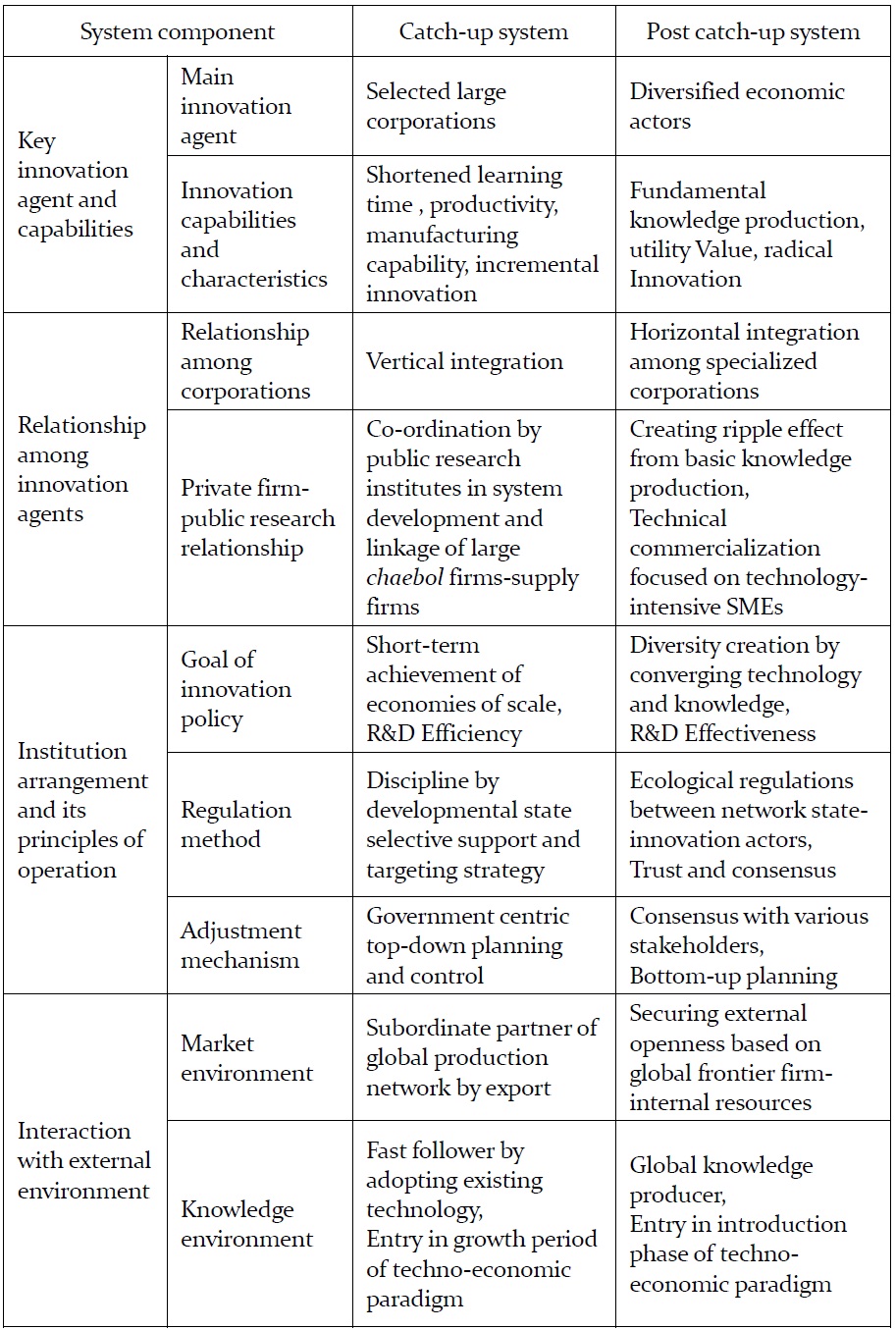
Catch-up and post catch-up innovation system: case of Korea
centralization effectively helped the nation to grow as a fast follower. It has the characteristics of top-down planning and control as a co-ordination mechanism. In terms of the interaction with the global environment, starting from an export-oriented subordinate partner of a global production network relying on foreign technology and markets, Korea developed to achieve manufacturing capability and product innovation.
However, the environmental changes due to two transitional aspects require the system transition summarized in Table 1. The post catch-up innovation system is expected to deal with diversification of economic actors, horizontal linkage among technology-based specialized firms, basic knowledge creation in the public sector, and strengthened technology commercialization based on technology-intensive SMEs while emphasizing basic technology production, new utility creation, and relatively radical innovation. The role of the state should be that of coordinator among various innovation actors and facilitator to support learning and capability building rather than the developmental state acting as a control mechanism. Emphasizing openness to utilize external resources based on the internal capabilities accumulated during the catch-up stage, it should concentrate on capability accumulation and activities in terms of interaction with the external environment.
Ⅳ. Innovation Policy for Post Catch-up
1. Role of the State in the Post Catch-up Era
1.1 Emergence of Network State Theory
Through reflection about the dissatisfying results from the policy with neoliberalism, represented by the Washington Consensus2, discourses regarding the need for new industrial policy and the definition of the government role have recently emerged. In the case of developed countries, environmental factors leading to complex interaction among industries, firms, government, and non-profit organizations such as convergence among technologies and industries and low carbon economy caused the new stream of arguments. The U. S. industrial policy facilitating innovation and emphasizing systematic linkages of industries-universities-public research institutes after the 1980s is considered the source of the industrial policy of the ‘network developmental state’ (Block, 2008; Rodrik, 2007).
Based on the dichotomy between the developmental state and market, previous arguments of industrial policy utilized the grounds of market failure and government failure as the basis of policy intervention. Developmental state theory based on the successful industrialization of East Asia insists that information protection enables the industries to create a dynamic competitive advantage while nations can pursue economic growth by strategic/selective intervention during the process. On the other hand, neo-liberalism and relating ‘new public management theory’ focused on the fact that government failure can be more serious than market failure.
Although new industrial policy arguments have some differences with one another, all find the basis of policy intervention in terms of network failure rather than the failure of market or government. Network failure refers to the situation in which network governance is not ideally formed or does not function. Schrank and Whitford (2011) categorized it as i) network failure due to opportunism and ii) network failure due to the lack of capability.
Network developmental state theory assumes that both government and market do not have perfect information and rationality, but are the complementary ones co-evolving in their growth process. The approach recognizes ‘network’ as an alternative coordination mechanism. During the transition period of the paradigm, the importance of network can be magnified with increasing significance of converging technologies and knowledge.
These approaches are based on pragmatic thought postulating the strategic collaboration between public and private sectors at the horizontal level. Corresponding to the trend of globalization, decentralization, and decentralization of production, they established the role of the nation as mobilizing selective resources, providing windows of opportunity, and being coordinator and facilitator. These arguments differ from the previous discussion in that it emphasized various governance, especially network, rather than vertical and hierarchical means of co-ordination (Chung, 2012).
1.2 Network State Theory and Latecomer Countries
How can new industrial policy based on network developmental state theory be reinterpreted in the context of latecomer countries? Radosevic (2009) stated the characteristics of the post-Washington Consensus regarding technological catch-up as follows. First, it is a mezzo level approach focusing on the evolution of system and institution unlike the macroeconomic approach of the Washington Consensus or the approach of M. Porter (1990). Second, Post Washington Consensus treats industry acceleration, diversification, and restructuration as the key of growth policy. Lastly, as development is a heuristic process (Hausmann and Rodrik, 2003), the effect of uncertainty in technological change and development process needs to be recognized and considered institutionally.
In other words, this means the transition from a developmental state system where the planning is made by the controlled developmental state and selective industries or firms are strategically supported in the catch-up period. Development should be considered in terms of capability (Sen, 2001). Moreover, the rationale of industrial policy has to be based on the creation of positive externality coming from network learning and collective efficiency.
2. Principle and Practice of Post Catch-up Innovation Policy
The innovation policy changes of latecomer countries discussed above bring a number of implications for composing post catch-up innovation policy. A network based industrial policy of post catch-up requires different roles and mechanisms from the catch-up system. As developmental theorists indicated developmental states in the catch-up period are characterized by strong government intervention, selective support for economic actors and industries, introduction of criteria with carrots-and-sticks and competition, and political and institutional conditions which enable the operation (Aoki and Dore, 1996; Khan and Blankenberg, 2009; Chung, 2012).
Recent innovation policy suggests that a 'control-based developmental state' does not have sufficient competence to adapt to a technological environment with diversity and uncertainty. Post catch-up innovation policy should place an emphasis on a heuristic process by policy learning among various innovation actors, system reorganization to manage uncertainty as a growth driver, and the policy approach of recognizing technology or policy as fill-the-shelf rather than off-the-shelf. This policy needs to change the orientation of goal setting and evaluation principles from a return on investment (ROI) based approach to a capability and network asset enhancing approach.
Though the mechanism design for realizing these principles in the actual innovation process are a further research agenda, some examples can be given at an exploratory level: first, adopt a searching and collective learning centric planning system to encourage policy learning as a heuristic process; second, institutional arrangement for interconnection and learning based on publicprivate linkage; third, a political objective and evaluation system development based on capabilities and network assets (trust) enhancing; and, last, an open and decentralized decision making process.
2 The term ‘Washington Consensus’ was coined in 1989 by the economist John Williamson to describe a set of ten relatively specific economic policy prescriptions that he considered the "standard" reform package promoted for crisis-wracked developing countries. The prescriptions encompassed policies in such areas as macroeconomic stabilization, economic opening with respect to both trade and investment, and the expansion of market forces within the domestic economy. Williamson used the term to summarize commonly shared themes among policy advice by Washington-based institutions at the time, such as the International Monetary Fund, World Bank, and U.S. Treasury Department, which were believed to be necessary for the recovery of countries in Latin America from the economic and financial crises of the 1980s (Wikipedia).
This paper aimed at exploring the values and the elements of post catch-up innovation policy. It researched the changes of competition environment, the value of post catch-up innovation policy, and the distinctions between catch-up systems. In addition, it prefiguratively checked on the change of innovation policy theory of latecomer countries and suggested principles that apply to countries that could follow.
Empirical studies of the way to realize the value and content of post catchup innovation policy will be needed as future research. Future study of the planning and operations of innovation policy is expected to be very meaningful especially in that it provides an evolutionary model of innovation policy for latecomer countries.
